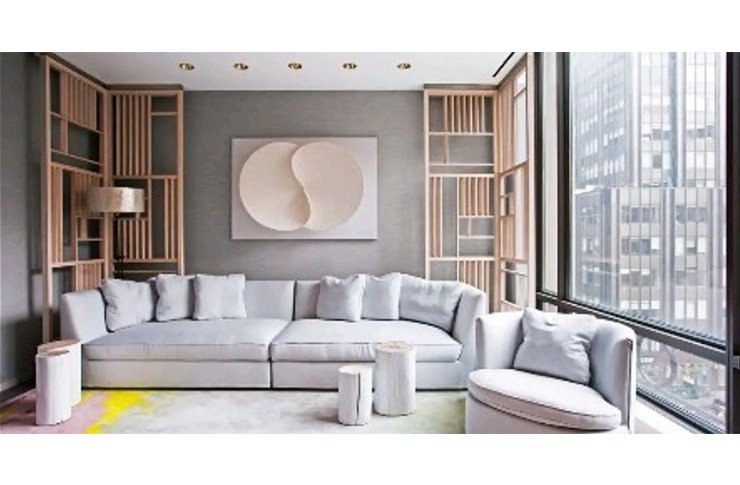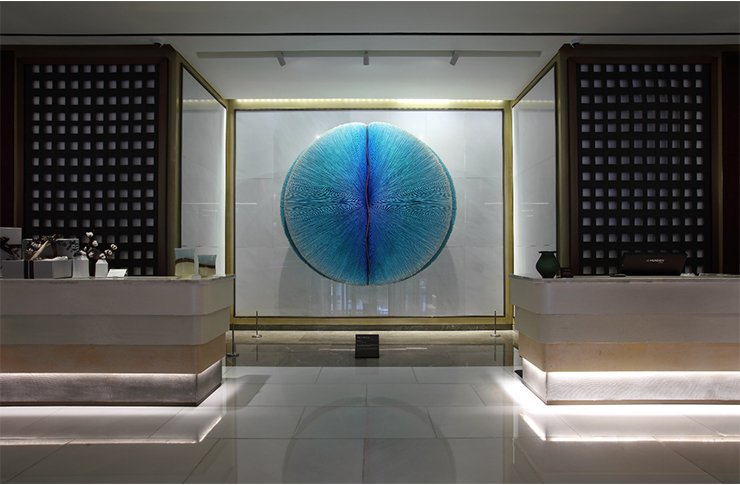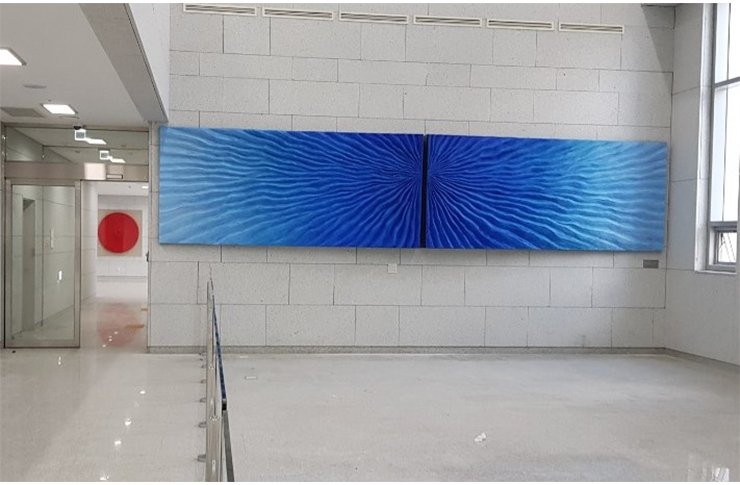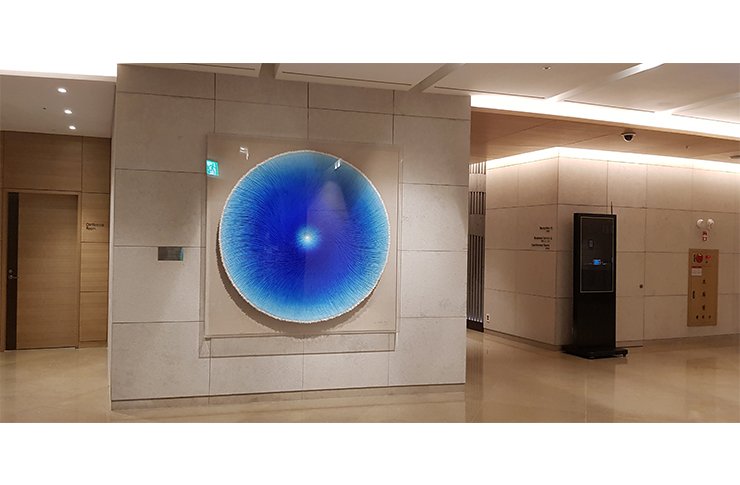조각가 인명사전
- HOME
- 조각가 인명사전

김희경
작가 작품
작가 프로필
1979 이화 여자대학교 미술대학 조소과
1987 이화여자대학교 대학원 조소과 졸업
• 개인전
2018 Galerie Uhn (쾌니히슈타인, 프랑크푸르트)
2017 갤러리 Q (긴자, 동경)
2016 Galleria Ponzetta (피에트라산타, 이태리)
2015 서울국제조각페스타 (예술의전당, 서울)
2014 서울국제조각페스타 (예술의전당, 서울)
2013 Galerie Uhn (쾌니히슈타인,프랑크푸르트)
2012 두원아트센터, 부산
아트 칼스루헤 (메세 칼스루헤, 독일)
2011 인사아트센터, 서울
2010 Jay갤러리, 서울
2009 서울 모던아트쇼 (예술의전당, 서울)
첸트로알랜더 아트센터 (라스페치아, 이태리)
2008 서울국제현대미술제 (코엑스, 서울)
2006 어반아트, 서울
2005 북경아트엑스포 (북경, 중국)
2003 페퍼스갤러리 (동경, 일본)
2000 선화랑, 서울
• 국제전 & 기획전
2019 KIM HeeKyung& Zhuang HongYi 2인전 (오페라갤러리, 서울)
종이충격전 (양평군립미술관, 양평)
2018 마이애미 컨텍스트 (마이애미, 미국)
2017 종이조형전 (뮤지엄 SAN, 원주)
마이애미 컨텍스트 (마이애미, 미국)
2015 퀼른 아트페어 (퀼른 메세홀1, 독일)
서울국제조각페스타, (예술의전당, 서울)
아트 칼스루헤 (메세 칼스루헤 , 독일)
2014 KIAF 2014 (코엑스, 서울)
스콥 바젤 (바젤, 스위스)
2013 아트 카스루헤 (메세 칼스루헤 , 독일)
스콥 뉴욕 (뉴욕, 미국)
2012 스콥 마이애미(마이애미, 미국)
슬렉션바젤 아트페어(바젤, 스위스)
LA아트페어(로스엔젤레스, 미국)
2011 스콥바젤 아트페어 (바젤, 스위스)
시카고 아트페어 (시카고 , 미국)
아트 칼스루헤 (메세 칼스루헤 , 독일)
2010 마이애미 아트페어 (마이애미 , 미국)
시카고 아트페어 (머천다이즈마트 , 시카고)
LA 아트페어 (LA 컨벤션센터 , 로스엔젤레스)
• 작품소장
국립현대미술관 / 예술의전당 / 청와대 / 터키대사관 / 신천지미술관 /
유타주립대학교(미국) / 갤러리아트빔 / 하남시청 / 명전대학교(대만) /
포시즌스호텔(서울, 뉴욕) / 르메르디앙서울호텔 / 제주롯데호텔/ 수원고지검청사
1987 이화여자대학교 대학원 조소과 졸업
• 개인전
2018 Galerie Uhn (쾌니히슈타인, 프랑크푸르트)
2017 갤러리 Q (긴자, 동경)
2016 Galleria Ponzetta (피에트라산타, 이태리)
2015 서울국제조각페스타 (예술의전당, 서울)
2014 서울국제조각페스타 (예술의전당, 서울)
2013 Galerie Uhn (쾌니히슈타인,프랑크푸르트)
2012 두원아트센터, 부산
아트 칼스루헤 (메세 칼스루헤, 독일)
2011 인사아트센터, 서울
2010 Jay갤러리, 서울
2009 서울 모던아트쇼 (예술의전당, 서울)
첸트로알랜더 아트센터 (라스페치아, 이태리)
2008 서울국제현대미술제 (코엑스, 서울)
2006 어반아트, 서울
2005 북경아트엑스포 (북경, 중국)
2003 페퍼스갤러리 (동경, 일본)
2000 선화랑, 서울
• 국제전 & 기획전
2019 KIM HeeKyung& Zhuang HongYi 2인전 (오페라갤러리, 서울)
종이충격전 (양평군립미술관, 양평)
2018 마이애미 컨텍스트 (마이애미, 미국)
2017 종이조형전 (뮤지엄 SAN, 원주)
마이애미 컨텍스트 (마이애미, 미국)
2015 퀼른 아트페어 (퀼른 메세홀1, 독일)
서울국제조각페스타, (예술의전당, 서울)
아트 칼스루헤 (메세 칼스루헤 , 독일)
2014 KIAF 2014 (코엑스, 서울)
스콥 바젤 (바젤, 스위스)
2013 아트 카스루헤 (메세 칼스루헤 , 독일)
스콥 뉴욕 (뉴욕, 미국)
2012 스콥 마이애미(마이애미, 미국)
슬렉션바젤 아트페어(바젤, 스위스)
LA아트페어(로스엔젤레스, 미국)
2011 스콥바젤 아트페어 (바젤, 스위스)
시카고 아트페어 (시카고 , 미국)
아트 칼스루헤 (메세 칼스루헤 , 독일)
2010 마이애미 아트페어 (마이애미 , 미국)
시카고 아트페어 (머천다이즈마트 , 시카고)
LA 아트페어 (LA 컨벤션센터 , 로스엔젤레스)
• 작품소장
국립현대미술관 / 예술의전당 / 청와대 / 터키대사관 / 신천지미술관 /
유타주립대학교(미국) / 갤러리아트빔 / 하남시청 / 명전대학교(대만) /
포시즌스호텔(서울, 뉴욕) / 르메르디앙서울호텔 / 제주롯데호텔/ 수원고지검청사
작가 노트
생명이 피어나는 기운 , 그 아름다움과 생명력이 각인되어 그 에너지의 파장 안에 나 자신의 모든 회한과 아픔을 맡긴다.
그 파장은 많은 사람들과 사물로 이어지고 나아가서는 광활한 대지와 깊은 바다로 번지며 , 일출의 찬란한 파장과도 맞닿게 된다.
대자연의 숨결과 나 자신이 합일되는 순간 , 나의 몸과 영혼은 그 파장과 어우러져 움직이기 시작하면서 아름다운 춤 이 된다.
그 순간 , 너와 내가 아무런 구분이 없다.
모두가 하나다. 완전한 평화다...
그 안에서의 자유로운 나의 춤은 ‘Bloom’ 이라는 흔적으로 남아 그 파장을 전파한다.
2011년 8월
김 희 경
Amid the vigor of blooming life and its beauty and vitality being imprinted,
all of my regrets and pains are washed away by its waves of energy.
The waves spread out and reach many people and things,
and continue out into the vast land and deep sea,
merging into the brilliant waves of the rising sun.
The moment the breath of Mother Nature and I myself become one,
my body and soul become part of the waves
and start to move in a beautiful dance.
At that moment, there is no difference between you and me.
All is one.
Complete peace...
My dance free inside remains as a trace that is a ‘Bloom' to spread the waves.
Kim Hui-gyeong
August 2011
평론
김희경의 작품세계
생명의 환희를 노래하는 우아하고 세련된 조형언어
신항섭(미술평론가)
지구가 우주에서 가장 아름다운 별의 하나일 수 있음은 뭇 생명체가 발산하는 생명의 광휘 때문이다. 자연의 아름다움이란 다름 아닌 생명의 빛을 의미한다. 아름다움의 근원으로서의 자연, 그 자연의 생명력에 대한 논의야말로 미학의 본질이다. 미술은 자연의 생명력이 발산하는 광휘의 빛을 시각적인 이미지로 표현한다. 신묘한 형태, 아름다운 색깔, 생동감, 그리고 감동을 조합하여 자연미와는 또 다른 차원의 조형적인 질서를 만들어내는 것이다.
김희경은 자연이 발산하는 생명의 빛을 추상적인 언어로 표현한다. 그의 작업에서 작품 하나하나는 독립적이면서도 완전한 형태를 지향한다. 그 형태는 지극히 자연스러울 뿐만 아니라 군더더기 없는 간결한 추상적인 형태를 보여준다. 구체적으로 그것이 무엇인지 정확히 말하기는 어렵지만 결코 낯설지 않다. 우리들의 시각적인 체험 그 어느 부분에 일치되는 점이 적지 않은 까닭이다.
그의 작업에서는 창작과 관련한 고통스러움이나 억지스러움의 흔적은 어디에서도 찾아낼 수 없다. 비록 작품의 피부는 거칠지언정 그 전체상으로는 섬세하고 여리다는 인상이다. 부드럽고 느리며 우아한 감정의 전개를 느낄 수 있음은 우연이 아니다. 뿐만 아니라 단순하고 간명한 조형적인 구조로 인해 시각적인 안정감을 느끼게 된다. 그처럼 함축적인 형태미를 찾아낸다는 것은 결코 용이한 일이 아니다. 예술가적인 명민한 미적 감수성이 아니면 그와 같은 아름다운 조형미를 요약해낼 수 없다. 그것은 진지한 관찰과 탐구 그리고 오랜 사색에 의해 조합된 조형언어인 것이다.
그의 최근 작업은 지극히 간결한 기하학적인 구조를 가진다. 처음에는 자연의 형태를 그대로 번안하는 경우도 있었지만, 그로부터 점차 간명한 구조로 변하게 된다. 가장 완전한 형태인 원형의 이미지 작업은 그가 추구하는 조형언어의 기본이다. 원형에 근접하는 완만하고 부드러우며 우아한 곡선으로 멋을 내는 간결한 구조 일색이다. 독립된 작품마다 크게 문제점이 없는 아름다운 형태로 이루어진다. 물론 작품에 따라 두 개 또는 세 개의 독립된 형태를 조합하기도 한다. 그러나 두세 개의 형태를 조합한 경우에도 그 전체는 단단히 결속된 하나로 보인다. 이는 이미 완벽한 조형적인 질서를 찾아냈음을 의미한다.
그의 작업은 이미지의 변주, 즉 형태의 변주라는 조형어법을 통해 다양한 이미지를 만들어내게 된다. 그의 작품 가운데 꽃잎이나, 씨앗, 풀잎을 연상시키는 이미지는 그대로 자연의 물상에서 취재한 것임을 말해준다. 그의 작품에 반영되고 있는 조형적인 상상은 우연적인 것이 아니다. 신비스러운 영감의 산물도 아니다. 자연미를 찬미하고 탐하는 그의 예민한 조형감각이 산출해낸 순수한 조형언어일 따름이다.
그러기에 구체적이고 세부적인 형태는 생략되었음에도 그로부터 자연의 원형을 읽어내는 것은 어려운 일이 아니다. 조형의 근본이 자연에 있으나 거기에 순응하지 않고 주관적으로 재해석한다. 그리하여 독립적인 조형공간을 창출하고자 한다. 이러한 욕구가 자연스럽게 추상적인 이미지로 이행하는 결과를 가져온다. 작업하는 과정에서 재료에 익숙해지고 조형적인 개념이 명확해지면서 점차 기하학적인 추상세계로 진입하게 된 것이다. 어떻게 하면 간결하면서도 명료한 조형언어로 자연의 미를 요약해 낼 수 있을까. 이와 같은 의지와 모색은 그의 작업을 보다 활성화시키는 직접적인 요인이다.
그가 만들어내는 형태는 확실히 일반적인 조형적인 사고의 영역을 넘어서는 것이다. 하지만 그처럼 아름다운 형태는 궁극적으로 자연을 향한 헌사일 따름이다. 경이로운 눈으로 자연을 탐색하는 데 대한 응당한 보상인 셈이다. 다시 말해 자연을 형성하고 있는 형태의 뼈대를 찾아내서 거기에 그 자신의 주관적인 조형의 법칙을 부여한다. 형태를 역추적하면 필경 자연의 이미지로 환원하리라는 생각은 억지가 아니다. 그만큼 그의 작품 하나하나는 자연미에 필적한다.
그렇다. 한지를 사용하는 최근 작업은 자연에 깃들인 생명의 파동을 구체화시켜 그 생명력이 뿜어내는 아름다움의 진가를 일깨워준다. 자연에서 채취된 천연의 재료로서의 친숙함과 부드러움은 생명의 기운을 표현하는데 효과적이다. 그 천연의 재료가 만들어내는 질료적인 느낌, 즉 텍스추어는 부드러움과 자연스러움이다. 부드러움은 유기질이라는 재료에서 비롯된다. 자연스러움은 텍스추어가 자연에 산재한 실재물의 어느 부분과 유사하다는데 있다.
한지라는 부드러운 유기물질을 피부로 하는 그의 작업은 자연성을 중시한다. 숨을 쉬는 종이로서의 한지, 즉 습기를 빨아들이는가 하면 내뿜으면서 자연의 변화에 민감하게 반응하는 재료를 사용함으로써 자연성에 귀속한다. 하지만 종이로서의 가치가 아니라, 질료로서의 가치, 즉 조형미를 관철하는 재료로서의 의미에 무게를 둔다. 그가 한지라는 재료를 중시하는 것은 부드러운 피부와 함께 회화적인 속성을 지닌 재료로서의 가치 때문이기도 하다. 다시 말해 한지는 채색을 수용하는 회화적인 영감 및 조형공간을 제공하는 것이다.
실제로 그의 작업에서 채색은 아주 중요한 조형적인 요소이다. 그가 조각가라는 사실을 알고 나면 채색에 의한 표현은 의외로 받아들여질 수 있다. 하지만 그의 작업은 분명히 평면작업은 아니다. 입체적인 공간을 수용하기 때문이다. 그럼에도 불구하고 최종적으로는 회화적이라는 의구심을 지울 수 없다. 한지라는 재료 및 채색기법을 원용함으로써 회화적인 속성이 강하기 때문이다.
그의 작업은 지적 조작의 산물이 아니라, 자연이 발산하는 생명의 파동 또는 생명의 광휘를 표현한다. 눈에 보이지는 않으나 엄연히 존재하는 자연에 내재하는 생명의 파동, 즉 울림을 예술가적인 미적 감수성으로 감지 감득하여 시각화하는 것이다. 빛과 소리를 연상케 하는 하나의 집중된 점으로부터 확산하는 이미지는 눈이 부실 지경이다. 확산되는 이미지는 파장, 파동 또는 흐름을 통해 생명의 빛을 질료로 바꾸어내는 까닭이다.
삶의 에너지로서의 빛과 파장은 모든 생명체를 활성화시키는 동력이다. 그 빛과 파장이 우리 몸에 들어오면 창의력과 같은 놀라운 능력으로 바뀐다. 그의 작업은 그처럼 고조되는 정신 및 고양되는 감각의 세계를 보여준다. 따라서 감상자 또한 작품 속에 내재하는 그의 미적인 체험을 공유하게 되는 것은 자연스럽다. 그런 형태의 감정이입이 어렵지 않은 것은 바로 그의 작품에는 시각적인 즐거움 또는 미적 감흥이 포진하고 있기 때문이다.
빛이나 울림 또는 떨림과 같은 확산하는 이미지는 정지된 상이 아니라, 움직이는 상이다. 진동에 의해 바르르 떠는 나뭇잎이나 연속적인 물결을 만들어내는 동심원과 같은 형태의 움직이는 상이다. 평면구조와는 확실히 다른 것이다. 비록 꽃잎과 같은 이미지는 평면적인 구조에 가깝다고 할 수 있지만, 그렇다고 하더라도 그 세부는 입체적이다. 떨림 또는 울림에 의해 만들어지는 파장은 공간의 문제이기에 그렇다. 다시 말해 그의 작업은 평면에서 살짝 벗어난 공간에 위치한다. 입체적인 시각으로 보면 평면에 가까운 듯싶고, 평면의 입장에서 보면 입체적이다. 이러한 구조는 그의 작업이 조각에 기반을 두고 있음을 말해준다.
실제로 둥근 원형의 이미지를 가지는 작품의 경우에도 파장의 이미지만을 표현하는 것이 아니라, 볼륨을 부여함으로써 입체공간을 점유한다. 그러면서도 전체적인 이미지는 평면회화의 정서에 근접한다. 그러고 보면 평면과 입체를 아우르는 그 중간항 즉, 절충의 공간을 상정하고 있음을 알 수 있다. 거기에는 평면에서 살짝 벗어나는 지점으로서의 릴리프가 존재하지만 릴리프는 온전한 입체공간이 아니라 평면에 근접하는 얕은 공간이다. 그 얕은 공간에 떠오르는 볼륨과 곡선은 지극히 우아하고 고상하며 세련되어 있다.
이처럼 평면에 미련을 두고 있는 것은 채색과 무관하지 않다. 다시 말해 평면작업에서 가장 중요시하는 색채를 도입함으로써 시각적인 인상으로는 평면회화에 가깝다. 물론 색채는 풍부한 시각적인 이미지 및 이해도 그리고 설득력을 높이는데 긴요하다. 이렇듯이 그의 작업에서 색채이미지는 아주 중요한 표현요소이다. 색채 자체가 지닌 시각적인 흡인력이야말로 조형의 또 다른 매력이다. 작품에 부여되는 색채이미지는 강한 재료에 의해 억압된 조각의 형식으로부터 일탈하고픈 그 자신의 잠재적인 욕구를 반영한다.
그의 작품 가운데 일부는 진정 아름답고 세련된 조형미를 보여준다. 인위적인, 즉 조형적인 아름다움은 세련미를 말한다. 세련미는 기술적인 완성도와 결부된다. 초기 작업들은 새로운 재료와 만났다는 흥분과 창작의 욕구가 넘쳐 거칠게 느껴지는데, 이는 당연한 일이다. 작업시간이 축적되면서 재료를 숙지하고, 표현기법이 안정되었는가 하면, 기술적인 완성도가 높아짐으로써 자연스럽게 세련미가 깃들이게 된 것이다.
그의 작업은 자연미에 원형을 둔, 조형의 전당에 비치된 목록에 추가시킬 만한 가치를 구현하고 있다. 이는 그의 작품세계가 인간의 조형감각이 경영할 수 있는 미적인 가치, 그 상한선에 도달하고 있음을 뜻한다.
The Art of Kim Hee-kyung
An Elegant and Refined Formative Language that Express esthe Joy of Life
Shin Hang-seop, art critic
Earth is one of the most beautiful planets in the universe because of the radiance that so many living things exude. The beauty of nature is nothing less than the light of life. Nature as the source of beauty and the vitality of nature seen in this way are the essence of aesthetics. Nature in its vitality emits light of brilliance, and art expresses this brilliance by visual images. The combination of mysterious forms, beautiful color, liveliness, and emotions produces yet another formative creation at a certain dimension that is distinguished from the beauty of nature.
Kim Hui-gyeong expresses the light of life emitted by nature by means of abstract language. Each and every single one of her works aspires to be an independent and yet perfect form. Her works are of absolutely natural forms, and are very neat, simple, and abstract. One cannot readily determine what any one of her works is, but they all seem familiar to us because they recall some part of our visual experience.
We cannot find any trace of pain or contrivance in the creation of Kim Hui-gyeong’s works whatsoever. Although the surfaces of her works are rough, we get an impression that her works are delicate and tender as a whole. It is not by chance that her works project soft, slow, and elegant emotion, and their simple, clear forms are calming and make us feel visually stable. It is never easy for an artist to find such implicative formative beauty. Without keen aesthetic sensitivity with an artistic temperament, no one can neatly define the astounding formative beauty as is seen in the works of Kim Hui-gyeong. Her art is formative language combined with earnest observation, exploration, and long meditation.
Her recent works are of extremely simple geometric structures. Her early works adapted forms of nature, and these gradually gave way to simpler and clearer forms. The image of the circle, the most complete of all forms, is the basic of the formative language she pursues. Most of her works are of simple structures with gentle and elegant curves that are nearly circular. Each individual work is of an independent beautiful form. Of course, she produces works which combine two or three independent forms. Even in such cases, the whole piece has a strong sense of unity. This means that she had already discovered the perfect formative order.
She works on variations of images. In other words, she produces diverse images through a means of formative expression characterized by variation of forms. In her works, we find images reminiscent of petals, seeds, and blades of grass, telling us that they are taken from objects in nature as they are. The imaginations embodied as forms in her works are products neither of chance nor mysterious inspiration. They are of a pure formative language produced by her keen artistic sense in which she admires and aspires to realize the beauty of nature.
It is not difficult for viewers to read the archetype of nature in her works though specific details are omitted. Nature is the basis of her sculpture, but she reinterprets it subjectively without adapting to it. By doing so, she aspires to create independent formative space, and this desire brings about a shift to abstract images in a natural way. In the course of working, she gradually entered into the geometric abstract world as she became familiar with materials and her concept about sculpture became clearer. Her commitment and exploration into how to express the beauty of nature by a simple, clear formative language are why her works are all the more powerful.
The forms she creates are surely beyond conventional thinking about sculpture. Nonetheless, such beautiful forms are ultimately tributes to nature. This is the reward she deserves for exploring nature by her extraordinary way of seeing. She finds structures of form in nature and applies them to her own subjective rules of sculpture. It would not be too much to say that any effort to trace her form to its source would bring one back to the image of nature. Each and every one of her works is equally beautiful as nature.
And yes. Her recent works on traditional Korean handmade paper called hanji embody waves of life in nature and remind us of the true value of beauty emitted by the vitality of nature.
Hanji, being material from nature, makes her works feel familiar and gentle, which is effective in expressing the vitality of life. The feeling created by material from nature, that is, the texture of her hanji works, is gentle and natural. The gentleness comes from material that is organic, and the naturalness is a result of the texture that is similar to certain parts of real things in nature.
Her works, the surfaces of which are made of the gentle organic material called hanji, emphasize naturalness. By using hanji, a type of paper that breathes, that is, a material that abs orbs or emits moisture sensitively in response to changes in nature, KimHee-kyung reverts to naturalness. However, she emphasizes its value as material, that is, material to achieve formative beauty, rather than value as paper. Another reason she values hanji is its painterly properties. That is, hanji accommodates coloring, providing painterly inspiration and formative space.
Actually color is a very important element in her work in general. When you hear that Kim Hui-gyeong is a sculptor, you might not expect to see expression by coloring. However, her works are not absolutely two-dimensional; they accommodate three-dimensions, but we cannot cast away doubts that her hanji works are ultimately painterly. This is because the use of hanji and the application of hanji coloring technique make her works more like paintings.
Her works are not products of intellectual manipulation. They express waves of life emitted by nature or the brilliance of life. Waves of life inherent to nature, that is, resonance, that cannot be seen with our eyes, are perceived by the aesthetic sensitivity of an artist and visualized. The image diffusing from one focused point reminiscent of light and sound is so amazing that it dazzles the viewer, because a diffusing image changes the light of life into material through waves and flow.
Light and waves as energy of life are power to revitalize all living things. When the light and waves enter inside us, they transform into astonishing capability such as creativity. Kim Hui-gyeong’s works show such spirit inspired and senses boosted. It is only, therefore, natural that the viewer should share Kim Hui-gyeong's aesthetic experience inherent to her works. Such empathy arises effortlessly because her works provide visual joy and aesthetic inspiration.
A diffusing image, such as light, resonance, and vibration, is one that is moving rather than standing still. It is an image moving like a leaf fluttering in the wind with vibration or a concentric circle creating circular waves successively. It is clearly different from two-dimensional painting. Although the petal image can be said to more like a two-dimensional form, its details are three-dimensional, because the impact created by vibration or resonance is about three dimensions. That is, her works are positioned in space slightly out of sync with the two-dimensional realm. When seen from a three-dimensional perspective, her works seem two-dimensional, and when seen from a two-dimensional perspective, they seem three-dimensional. This shows that her works are based on sculpture.
Even her works which are actually about the image of a circle occupy three-dimensional space as they are voluminous, rather than expressing images of only waves. Yet, the overall image is close to a two-dimensional painting. We can see that her works are about space of compromise, that is in-between space accommodating both the two-dimensional and the three-dimensional. Although there is relief since her works are not quite two-dimensional, the relief is low, making them nearly two-dimensional rather than perfectly three-dimensional. The volume and curve rising from the low space are extremely elegant, exquisite, and refined.
Her affection for the two-dimensional realm is not irrelevant to coloring at all. In other words, she uses colors which are most important in two-dimensional works, creating a visual impression that is close to two-dimensional painting. Of course, color is essential in projecting a rich visual image and in helping the viewers better understand her works and convincing them. In her works, color image is a very important element for expression. The visual charm of color itself is another attraction of artwork. The color image given to her works reflects her latent desire for deviation from the form of sculpture suppressed by powerful material (for sculpture).
Some of her works show truly beautiful and refined beauty. They involve artificial beauty, that is, refined beauty. Refined beauty is associated with perfection of techniques. Her early works impart a feeling of excitement of meeting new material and desire for creation, which is absolutely natural. As she gained more and more experience, Kim Hui-gyeong became well acquainted with material and her expressive technique stabilized. With her techniques approaching perfection, her works naturally acquired increasingly refined beauty.
Kim Hui-gyeong's work embodies values worthy of being added to the catalogue in the hall of sculpture, the original form of which is natural beauty. This means that her works reach the highest level of aesthetic value possible by human artistic sense.




